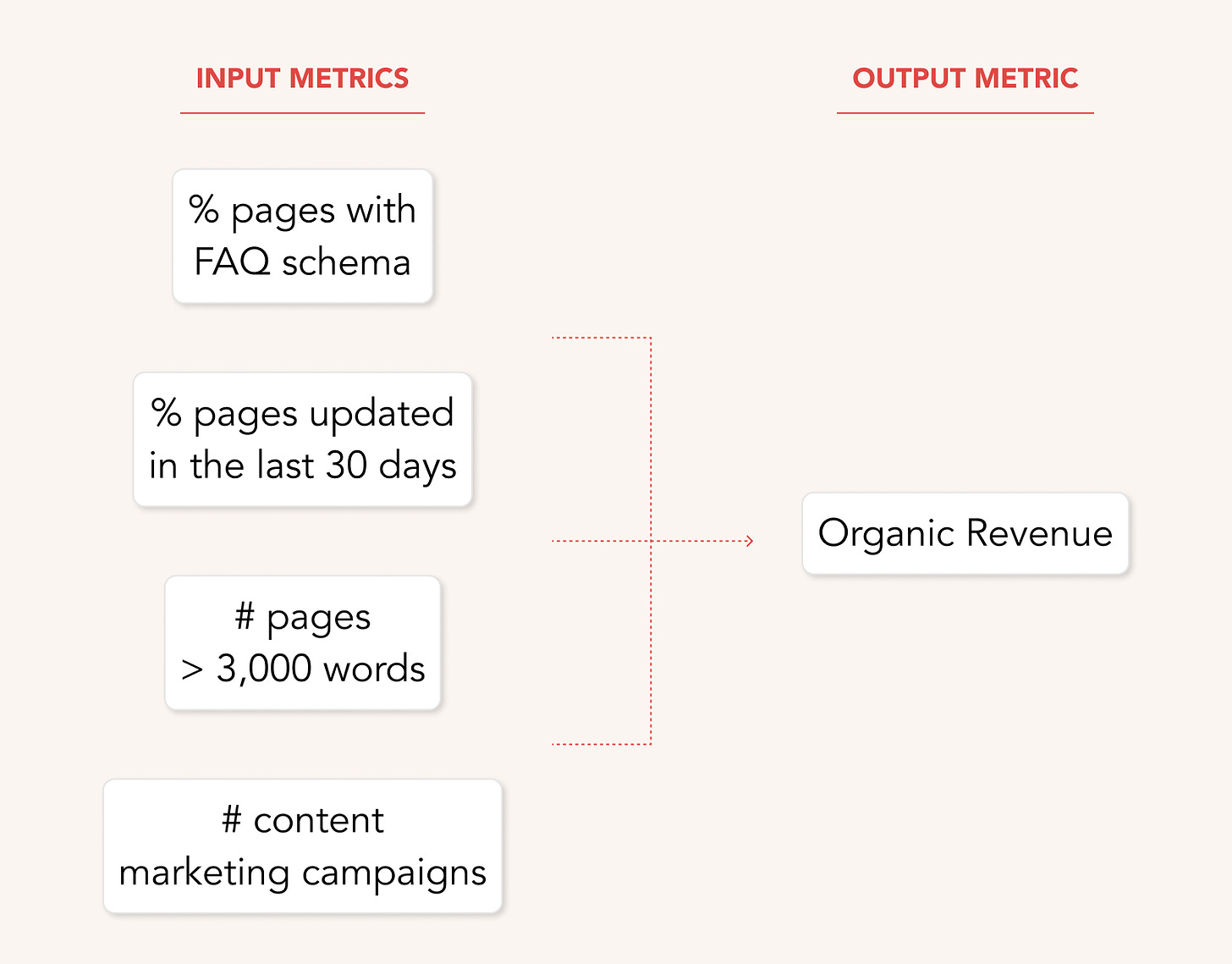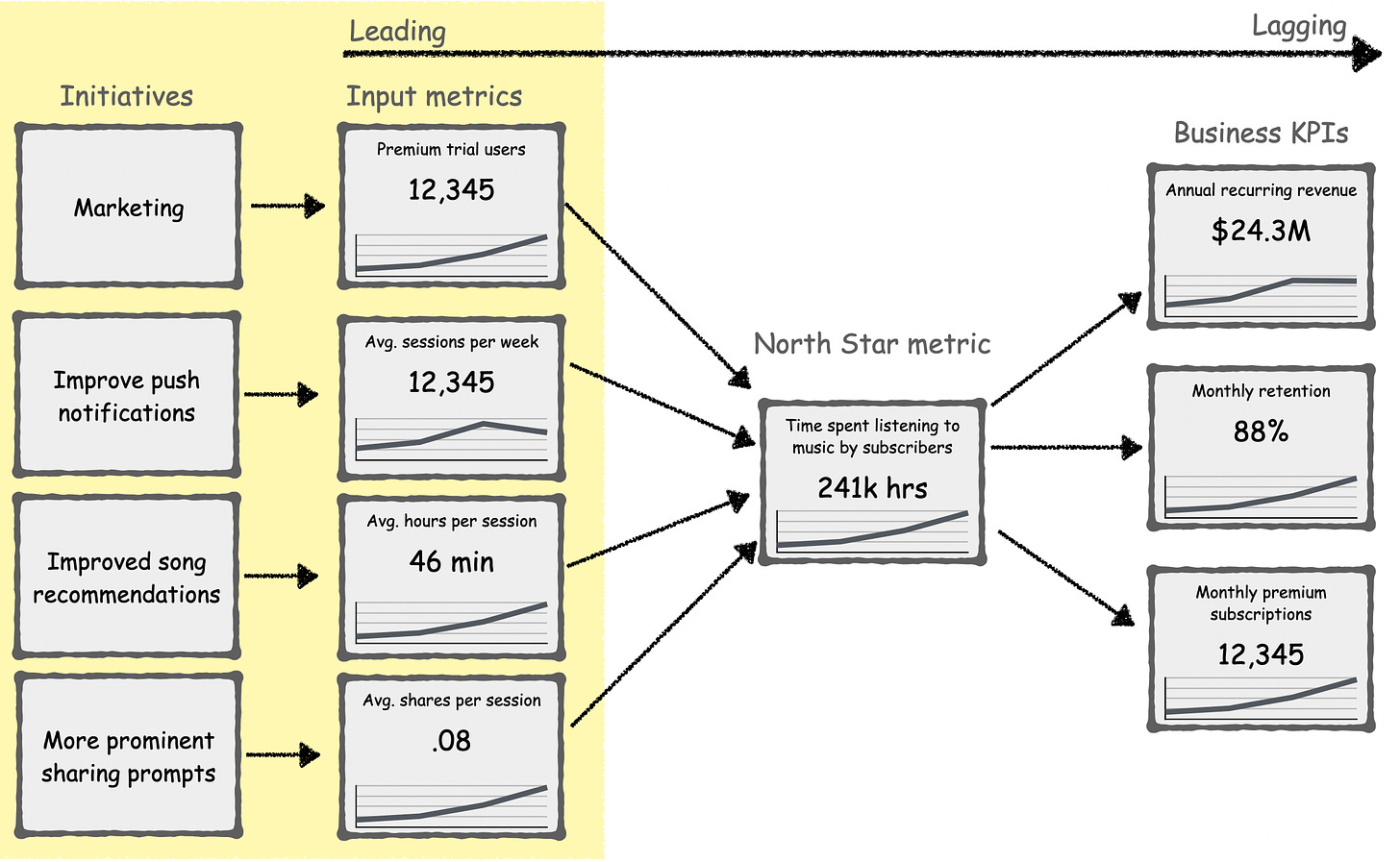A lot of CEOs have what I call a “black box” mental model of SEO that looks something like this:

This “black box” mental model is extremely unhelpful for an SEO program. In particular:
- It implies that the SEO team is the primary input into SEO success, which obscures the dependencies of the SEO program. As we discussed in Is SEO Worth It – SEO is actually a cross-functional program where most of the SEO success comes from activity outside of the SEO team.
- It’s not measurable – the only accounting here is the unit of “doing SEO” that you do.
In this article let’s explore how we can use input metrics to get buy-in for our work while ensuring executives across the business have a better mental model for how SEO works.
Reporting Reinforces Mental Models
We are often guilty of perpetuating this kind of mental model when all we do is report on outputs and outcomes. A common dashboard view looks like this:

All we’re reporting on is outputs.
Reporting on outputs is measuring what has happened. Measuring what has happened is important, obviously, but it’s a bit like driving a car by only looking in the rear view mirror…
It’s also important to measure what is happening.
Rankings, traffic and revenue are LAGGING indicators of success. They are the results of work done in the past. What we need to find are LEADING indicators – the things that tell us how we’re doing right now, at things that can cause success in the future.
What we need are input metrics:
Introducing Input Metrics
Amazon runs their business not on outputs but on inputs. The book Working Backwards goes into detail and I’d definitely recommend it. Cedric Chin has a nice primer:
The simple answer is that we are not taught to think like this. When people say “be more data driven”, we immediately assume, “oh, we have to measure our business outcomes”. And so we measure things like number of deals closed, or cohort retention rates, or revenue growth, or number of blog visitors. These are all output metrics — and while they are important, they are also not particularly actionable.
Amazon argues that it’s not enough to know your output metrics. In fact, they go even further, and say that you shouldn’t pay much attention to your output metrics; you should pay attention to the controllable input metrics that you know will affect those output metrics. It is a very different thing when, say, your customer support team knows that their performance bonuses are tied to a combination of NPS and ‘% of support tickets closed within 3 days’. If you have clearly demonstrated a link between the former and the latter, then everyone on that team would be incentivised to come up with process improvements to bring that % up!
In essence, output metrics represent outcomes or results while input metrics represent actions.
The more you read about this the more you feel like this is deeply ingrained across Amazon in a way that has shaped the organizational psyche.
Note that input metrics fall into two types:
- those that are strictly within your control, these are “true” input metrics e.g. “number of pages published this month”.
- “mini lag metrics” that are not completely controllable, but are directly measurable and change in direct response to our actions. This could be something like # pages crawled in the last 30 days, or # of outreach responses.
Either way, the key is to choose input metrics that are measurable, change in response to our actions, and we believe predict success.
Example SEO Input Metrics
Let’s look at how we might create some input metrics for SEO. Remember the goal here is to demystify the “black box” – so what are the key factors that we can directly control that will result in SEO performance?
The most basic set of input metrics might look something like this:

Links + content = SEO! We’re all pretty familiar with this.
Of course, ideally you want to tailor the metrics to your own specific situation and goals. So for a content program we might do something like this:

There is no one-size-fits-all approach here! Yes there are 1,000s of ranking factors but no you shouldn’t have 1,000s of input metrics. The key is to choose ones that are specific to your situation / business / needs and crucially that align with your plan – what are you going to do? Those activities point the way to input metrics.

Obviously this is just a sampling – you’ll need to think carefully about which ones you choose.
As we get more sophisticated we can start grouping and chaining these together:

Notice how abstract intentions like “improve content quality” are now measurable – we have something an executive can understand here! We’re starting to demystify the black box of “do some SEO”.
Input Metrics Create Better Mental Models
Reporting on input metrics should enable the senior stakeholders across the business to better understand how SEO works – and all the levers the company can pull to influence success.
Importantly – you can start to map out which teams are responsible for the various input metrics:

By communicating your strategy this way, and making the various inputs measurable it helps executives across the business understand the cross-functional effort required to achieve SEO success.
Input Metrics are Not Neutral!
Something important to understand about input metrics – they are not neutral! There are a ton of things that you could use as input metrics, but by carefully choosing the input metrics you’re communicating to the business that these metrics are the ones that will move the needle.
Input metrics are embedded expertise! You’re supposed to use your SEO experience and judgment to identify the things you think will have the greatest impact on the business. This requires subjective expertise! There are, obviously, a TON of things that could potentially impact SEO performance. The key is to try and build a report that focuses on the key ones – either the ones we are directly trying to influence, or the ones most likely to impact results.
Input metrics are cross-functional! Note how in the above example there are many inputs that might be entirely beyond the control of the SEO team (e.g. # of new products on the site). This is important however because while influencing that input metric might be beyond the control of the SEO team, it absolutely impacts the SEO performance.
Input Metrics are More Measurable
The good news about input metrics is that they allow you to report on progress even if you’re not seeing results yet. This is a key step towards being seen as more credible by senior leadership – instead of saying “it depends” or “we’re not seeing results yet” or “SEO takes time” you can say “we’ve improved our input metric X%!”
The bad news about input metrics is that they often rely on metrics that aren’t readily available in Google Analytics. For example the number of new pages created on the blog might rely on a spreadsheet calculation. Or the number of products with a unique description might require a custom crawl of the website. You’ll notice, however, that coming up with ways to measure these input metrics over time is often very valuable work!
Input Metrics are how you Manage an SEO Program
Once you have the foundational mental model for how the metrics sit together you can start to connect all your initiatives directly to measurable metrics. This is a common methodology in the product world, but rarely talked about in SEO circles.
Daniel Schmidt, CEO of doubleloop has a nice visual in his post Why business intelligence falls flat showing how initiatives, input metrics, north star metric and business KPIs all fit together (the images is an example for how Spotify might connect initiatives, input metrics, north star metric and business KPIs):

Now, not only do we have the mental model for “what levers influence SEO” but also “what levers are we trying to pull right now, and how”. This essentially puts the entire SEO program on one page! Great for executives.
Aside: I really like how Doubleloop is creating visual real-time metric dashboards. See the live example here. And here’s a simple example B2B SAAS template that I created in Doubleloop.
Input Metrics Should Evolve
Finally, one key aspect of input metrics is that you should be evolving these over time as you get more information. From the book “Working Backwards”:
When we realized that the teams had chosen the wrong input metric—which was revealed via the WBR [weekly business review] process—we changed the metric to reflect consumer demand instead. Over multiple WBR meetings, we asked ourselves, “If we work to change this selection metric, as currently defined, will it result in the desired output?” As we gathered more data and observed the business, this particular selection metric evolved over time from:
- number of detail pages, which we refined to
- number of detail page views (you don’t get credit for a new detail page if customers don’t view it), which then became
- the percentage of detail page views where the products were in stock (you don’t get credit if you add items but can’t keep them in stock), which was ultimately finalized as
- the percentage of detail page views where the products were in stock and immediately ready for two-day shipping, which ended up being called ‘Fast Track In Stock’.
Let’s imagine that we’re managing SEO for a site like Nerdwallet. One of our input metrics might be something like “number of pages live” – i.e. the more pages we publish the better.
But this is a pretty crude metric – you can easily see how “number of pages live” might not predict SEO success particularly well. So maybe you would evolve the metric like this:

This kind of evolution is essentially starting with a simple, easy to measure metric and gradually iterating over time as we learn which metric is the best predictor of success, and how to measure the more specific, relevant version of the metric.
Importantly, a good input metric serves two purposes. Firstly it helps you predict success – i.e. if we move this metric then results should follow. But secondly, it helps people inside the business know what to do.
This second point is not to be overlooked – a reporting framework is a communication and coordination tool. So, one reason to iterate our input metrics is to better predict success – and another reason is to ensure various teams across the business are doing what you want them to do.
Don’t underestimate this second piece!
In Summary: Executives don’t invest in things they don’t understand and can’t measure
Executives don’t tend to invest in something that they don’t understand and can’t measure. So even though organic revenue is easy to understand and important, SEO is often under-funded and neglected. Input metrics are one way to ensure that we are helping decision makers understand how SEO works AND how they can invest in SEO success.
After all – consider this. If you CAN’T show input metrics, what’s the alternative? You ask for more SEO budget for…. what? A bigger black box?
